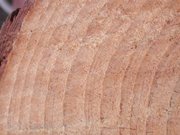Dendrochronology
|
|

Pine_tree_rings.JPG
Dendrochronology or tree-ring dating is the method of scientific dating based on the analysis of tree ring patterns. This technique was invented and developed during the 20th century originally by A.E. Douglass, the founder of the Laboratory of Tree-Ring Research which resides at the University of Arizona. This dating technique can give dates in exact calendar years for wood.
| Contents |
Overview
Simply stated, many trees in temperate zones grow one growth ring each year. For the entire period of a tree's life, a year-by-year record or ring pattern is formed that in some way reflects the climatic conditions in which the tree grew. Adequate moisture and a long growing season results in a wide ring. A drought year may result in a very narrow one. Trees from the same region will tend to develop the same patterns of width for a given period. These patterns can be compared and matched ring for ring with trees growing in the same geographical zone and under similar climatic conditions. Following these tree-ring patterns from living trees back through time, chronologies can be built up. We can thus compare wood from old or ancient structures to our known chronologies, match the ring patterns (a technique called cross-dating), and determine precisely the age of the wood used by the ancient builder.
In areas where the climate is reasonably predictable, trees develop annual rings of different properties depending on weather, rain, temperature, etc. in different years. These variations may be used to infer past climate variations — see dendroclimatology.
More detail
Laboratory analysis of timber core samples measures the width of annual rings. By taking samples from different sites and different strata within a particular region, researchers can build a comprehensive historical sequence that becomes a part of the scientific record; for example, ancient timbers found in buildings can be dated to give an indication of when the source tree was alive and growing, setting an upper limit on the age of the wood. Some trees are more suitable than others for this type of analysis. Likewise, in areas where trees grew in marginal conditions such as aridity or semi-aridity, the techniques of dendrochronology are more consistent than in humid areas. These tools have been important in archaeological dating of timbers of the cliff dwellings of Native Americans in the arid Southwest.
Scientific value
A benefit of dendrochronology is that it makes available specimens of once-living material accurately dated to a specific year to be used as a calibration and check of radiocarbon dating. The bristlecone pine, being exceptionally long-lived and slow growing, has been used for this purpose, with still-living and dead specimens providing tree ring patterns going back thousands of years. For dating purposes, in some regions sequences of more than 10,000 years are available.
The dendrochronologist faces many obstacles, however, including some species of ant which inhabit trees and extend their galleries into the wood, thus destroying ring structure.
Similar seasonal patterns also occur in ice cores and in varves (layers of sediment deposition). These are used for dating in a matter similar to dendrochronology, and such techniques are used in combination with dendrochronology, to plug gaps and to extend the range of the seasonal data available to archeologists.
One problem that archaeologists have when using dendrochronology is that while they can use the technique to age the piece of wood, and when it was felled, it may be difficult to use that to definitively determine the age of a building or structure that the wood is in. The wood could have been used for something else first, may have been felled and left for many years before use, or could have been used to replace an older rotten or broken piece of wood.
See also
External links
- The Laboratory of Tree-Ring Research (http://www.ltrr.arizona.edu)
- Wiener Laboratory for Aegean and Near Eastern Dendrochronology at Cornell University website (http://www.arts.cornell.edu/dendro/)
- Dendrochronology on musical instruments and art objects (http://www.dr-beuting.de/index_en.php)
- University of Tennessee Dendrochronology (http://web.utk.edu/~grissino/)
- Oxford Dendrochronology Laboratory (http://www.dendrochronology.com/)da:Dendrokronologi
de:Dendrochronologie eo:Dendrokronologio fr:Dendrochronologie it:Dendrocronologia nl:Dendrochronologie sv:Dendrokronologi
